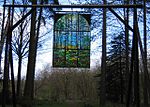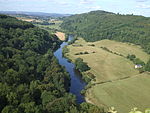Foxes Bridge Bog
1977 establishments in EnglandBogs of EnglandForest of DeanNature reserves in Gloucestershire

Foxes Bridge Bog (grid reference SO630125) is a 5.3-hectare (13-acre) nature reserve in Gloucestershire. The site is owned by the Forestry Commission and is managed by the Gloucestershire Wildlife Trust in partnership with the Forestry Commission. The site is listed in the 'Forest of Dean Local Plan Review' as a Key Wildlife Site (KWS).
Excerpt from the Wikipedia article Foxes Bridge Bog (License: CC BY-SA 3.0, Authors, Images).Foxes Bridge Bog
Speech House Road, Forest of Dean
Geographical coordinates (GPS) Address Nearby Places Show on map
Geographical coordinates (GPS)
| Latitude | Longitude |
|---|---|
| N 51.810355555556 ° | E -2.5373611111111 ° |
Address
Speech House Road
Speech House Road
GL16 7EL Forest of Dean
England, United Kingdom
Open on Google Maps









